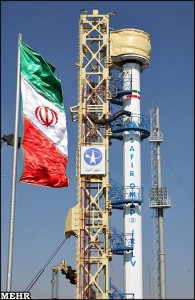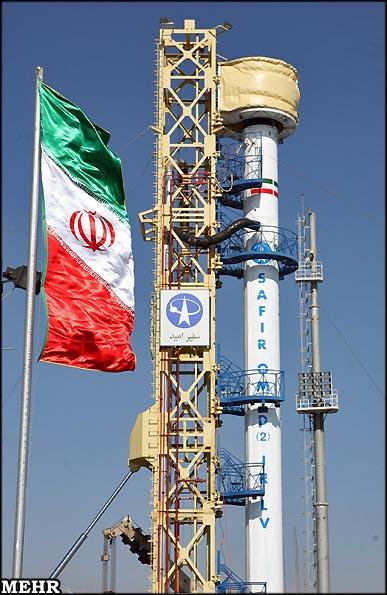 Iran’s recent successful launch of a second satellite into orbit has drawn considerable attention around the world. As in the past, Iran’s announcement of the launch of its domestically built satellite into space received mixed reactions in the West. Some mainstream U.S. media treated the announcement with skepticism and ridicule. “Before you cancel that European vacation or start building a bomb shelter, it’s worth taking Iran’s boasts with a grain of salt,” one commentator wrote in Wired. “While Iran has cooked up some indigenous weaponry over the years, its desire to puff out its chest and pronounce immunity from the effects of international sanctions has led to some absurd exaggerations and outright lies.”
Iran’s recent successful launch of a second satellite into orbit has drawn considerable attention around the world. As in the past, Iran’s announcement of the launch of its domestically built satellite into space received mixed reactions in the West. Some mainstream U.S. media treated the announcement with skepticism and ridicule. “Before you cancel that European vacation or start building a bomb shelter, it’s worth taking Iran’s boasts with a grain of salt,” one commentator wrote in Wired. “While Iran has cooked up some indigenous weaponry over the years, its desire to puff out its chest and pronounce immunity from the effects of international sanctions has led to some absurd exaggerations and outright lies.”
To the surprise of such skeptical observers, it was only a matter of hours before independent sources, including some websites associated with NASA, verified the successful launch of Iran’s Rasad satellite by tracking its current position in space. Despite strong motivations for skepticism toward anything positive coming out of Iran, some fair-minded Western observers did not shy away from expressing their independent observations on Iran’s recent satellite launch either. “People wondered after the first time if they just got lucky,” one analyst observed in New Scientist. “Now that they’ve put two satellites up there, that indicates perhaps it wasn’t a fluke the first time. It demonstrates that their rocket technology is pretty good.”
Apart from Israel which follows even a more hard-line stance than the United States toward Iran’s technological achievements and views Iran’s space program as a cover for the development of long-range ballistic missiles, regional reactions to Iran’s recent satellite launch and its plan for more launches in the near future have largely been mute. This silence should not come as a surprise knowing that major regional countries including Saudi Arabia and Turkey have their own developing space programs and have already had several satellites launched into orbit with the help of foreign countries. In fact, some defense experts consider certain space activities of some of these regional countries even far more mature than Iran’s, even though their activities are not a source of Western concern.
Some major countries, such as Turkey, do not consider Iran a threat to their national security. They are also less worried that Iran’s space program is a cover for developing long-range ballistic missiles since Iran’s existing missiles can already reach most of their territories. Russia has also refrained from overreacting to Iran’s space activities for fear that the West would have one more excuse to use Iran as a rationale for building missile shields in Eastern Europe. In the past, Russia has restrained its cooperation with Iran in space activities to facilitate cooperation with the West in other arenas.
Why Satellites?
Although some Iranian officials, including President Mahmoud Ahmadinejad, tend to overstate the nature of Iranian scientific advances, independent experts and science analysts believe that Iran has established itself as the scientific and technological powerhouse in the region. For example, Jane’s Intelligence Digest reported in recent years that “Tehran now has established its status as having the most advanced space, missile and nuclear programs in the Muslim Middle East, confirming its technical superiority over its Arab rivals.” According to the UK’s Royal Society, Iran has also recorded the world’s fastest scientific growth over the past 15 years, with scientific output rising 18-fold from 1996 to 2008.
But Iran has also made choices about where it puts its money, making large investments in such advanced technological fields while neglecting investments in other crucial sectors such as oil refineries. Such a neglect has cost Iran well over one hundred billion dollars of hard-earned foreign exchange through the import of gasoline over the last three decades and exposing it to the threat of gasoline embargo by its sworn adversaries.
The dominant narrative among Western politicians and in mainstream Western media is that Iran uses its satellite launches as a cover to develop long-range ballistic missile technology. The same technology used to launch satellites into space can with some modifications deliver conventional and non-conventional warheads over a long distance to hit targets, for example, in Western Europe or even in the United States.
This line of argument suffers from two main problems. First, Iran is already subject to harsh economic sanctions imposed by Western powers, so it doesn’t need a cover to develop long-range ballistic missile technology. Also, nothing prevents Iran from the perspective of international law from developing long-range ballistic missiles if they are only capable of delivering conventional warheads.
Second, Iran does not define for itself a global military role that necessitates the development of long-range ballistic missile technology. Long-range ballistic missiles cannot significantly increase Iran’s deterrence against extra-regional powers given that these countries are already equipped with missile defense shield technology that enables them to destroy incoming missiles in the air, particularly from countries less advanced in the area of missile technology. Iran simply pursues military deterrence against regional adversaries, which are located within the striking distance of its various missiles, as well as against those extra-regional powers which have military bases in the region.
Iran’s modest military expenditures as compared to even some of its small neighboring countries and the overwhelmingly defensive nature of its military capabilities all point to the fact that Iran does not seek military roles beyond its means. According to the Middle East Journal, the six Arab members of the Persian Gulf Cooperation Council, with a combined population less than one-third of Iran, spent 7.5 times as much on their defense as Iran from 1997 to 2007. Similarly, they spent 15.6 times as much on arms procurement as Iran during the same period.
Iran’s main goal for developing satellite technology is to reap the strategic and political benefits emanating from the very space presence itself. Possessing the technology to build satellites and launch them into space gives Iran strategic benefits in both civilian and military arenas over the long run. Self-sufficiency in the production and launch of satellites to provide telecommunications and possible military reconnaissance services is an important national security goal for Iran. Its arch rivals in the region either already possess such technologies or can rely on Western support for providing these services. Facing a hostile West, Iran can’t rely on already existing satellite services and technologies.
Iran’s National Self-image
Political motivations are also a driving force behind Iran’s growing space program. Space activities along with nuclear power and stem cell research, in which Iran has made significant investments over the past few decades, possess symbolic value for Iran as vanguard scientific fields. By developing its capacities in advanced scientific and technological fields, Iran aims to develop a new national self-image and improve its international prestige.
Although Iran was one of the few countries in Asia and Africa which escaped direct colonization in the late 19th and early 20th centuries, in large part as a result of great power rivalry between Tsarist Russia and Britain, it did experience indirect colonial domination. To Iranians, the experience of neo-colonial domination signified Iran’s absolute and relative decline in scientific, military, and economic power over the past several centuries. For a nation once at the forefront of world civilizations, this experience of decline provoked national soul-searching by both religious and secular intellectuals and spurred calls for a national renaissance.
Iran’s efforts at expediting its scientific and technological development over the past few decades demonstrate the country’s strong desire to break into the rank of the world’s most technologically developed nations and bid farewell to its status as a Third World country. The statements of various top Iranian officials to the effect that Iran has now entered the space club and the nuclear club, or that it has become a pioneering country in stem cell research, all signify Iran’s struggle to acquire a new global status. Defense Minister General Ahmad Vahidi’s statement that the successful launch of the Rasad satellite into orbit is “good news for all those who think of Iran’s glory” is meaningful in this regard.
Iranian officials have set ambitious goals for their space program. The national goal of landing an Iranian astronaut on the moon by 2025 may not seem realistic to outside observers, but it has the effect of creating pride in the future for Iranian citizens and boosting their national self-image. The Iranian state can also benefit from enhanced political legitimacy at home. Scientific and technological achievements present the image of an efficient and competent government to the public. This increased stock of social capital can go a long way in helping the government survive other possible shortcomings and inefficiencies along the way. Understanding the politics of Iran’s technological development should serve as a check on the unwarranted paranoia that Iran’s scientific achievements have generated in the West.

